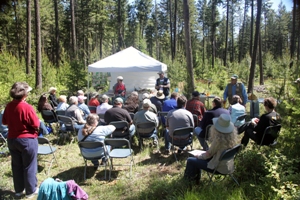 To help forests adapt to changes in climate, landowners must consider several aspects of land management.
To help forests adapt to changes in climate, landowners must consider several aspects of land management.
Rising temperatures and changing precipitation patterns already are having an effect on the nation’s forests, on both public and private lands. The ongoing climate change will likely have an impact on every aspect of the forest ecosystem, from the top of the canopy down to the soil below the surface. Still, it remains difficult to predict the fate of future forests given the many uncertainties involved – not only in how, exactly, the climate will change at the local scale of a forest, but also in how various species within the forest will respond to these changes.
No single solution or management approach will be appropriate to all or even most situations. The diversity of resource contexts has always required that place-based and individualized prescriptions be developed; the climate-change context magnifies this reality. Given that climate model projections operate at a much larger scale than the forest stands managed by public workers and private landowners, many management decisions will require a broad understanding of projected climate changes as well as a much finer understanding of ongoing changes within the stands in question.
When considering how to manage forests as climate changes, the following broad suggestions are worth keeping in mind. More specific details will follow in other sections.
- Embrace and work with change. While this may seem obvious, many existing resource management practices rest on assumptions that ecological backgrounds are stable over time even though they acknowledge short-term successional dynamics. Likewise, ingrained institutional traditions commonly rest implicitly on assumptions of persistent and stable behavior. Make friends with change, while still working to mitigate it.
- Accept uncertainty as a premise for decision making. While opportunities for prediction and forecasting will be presented to managers, uncertainty will always lurk close at our shoulders – at least at the scale relevant to most resource-management projects. Addressing uncertainty head-on will often be more effective than taking a course of action based on a narrowly defined future. For many situations, there will never be enough knowledge to predict future outcomes at scales that matter to managers. Evaluate the wisdom of “putting your eggs in one basket” (accepting a definite future) versus “hedging your bets” (accepting uncertainty) strategies.
- Recognize that some existing management paradigms have limited value. This is because many traditional practices are based on assumptions that the future will be similar to the past – that ecosystems are not changing over time. Climate change puts that notion finally to rest. Yet many ecosystem management philosophies will still make sense, especially when practiced creatively. This is a good time to experiment with old techniques in new ways and to pioneer altogether novel approaches.
- Manage for desired future processes rather than desired future conditions. Composition and structure relate to static rather than dynamic goals; a focus on ecosystem services and ecological and physical functions as management targets fixes the aim on dynamic process.
The tips above apply to managers of both public and private forests and woodlands. The following sections are divided into suggestions more specific to public versus private foresters, although some might find both sections worth exploring.
Resources available in Climate Change Adaptation for Forests:
- Adaptive Forest Management Strategies
- Management Strategies for Family Forests
- Conservation Priorities
- Risk Management in Adaptation Strategies
In Caring for Forests:
- Climate Change Adaptation for Forests
- Changes in Natural Resource Economics
- Silviculture and Climate Change
- Forest Carbon Storage
